Here we are with another installment of Genre Spotlight! This time around, Sega-16 takes a look at the multitude of fighting games available on the Genesis. Not all are worth playing, but many will surprise you, given the chance. For a console not widely regarded for its fighters, Sega’s little black box had more than a respectable share. In fact, some are considered bona fide classics (Eternal Champions, Street Fighter II CE). Regardless of your taste in brawlers, you’re sure to find something worth your time here.
I’m sure that many will read this list and come to the conclusion that most of what’s here isn’t worth playing. One has to keep in mind that most of these games were released during a period when fighting games weren’t the big draws in arcades. Developers at the time were really just following the leaders – Street Fighter II, Mortal Kombat, & the multiple Neo Geo titles like Fatal Fury – and the genre can really be said to have been going through some growing pains. Think of it this way: the Genesis didn’t get any truly memorable fighting games until 1993, which was almost halfway through its life span. Just compare early fighters like Ka-Ge-Ki and Street Smart to later releases like Eternal Champions: Challenge from the Darkside and Super Street Fighter II Turbo. The jump in quality is easily notable.
Art of Fighting
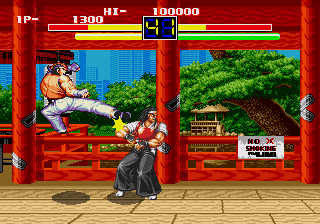 Back in the early ’90s, Capcom was riding high on the success of Street Fighter II. Deciding to take advantage of its immensely powerful MVS hardware, SNK shot right back at their success by releasing a deluge of fighting games of their own. Among the constant stream of releases was Art of Fighting, which wowed gamers with its huge sprites and dizzying zoom feature. Considering the extent of the downsizing that had to be done to get the game to fit on a Genny cart, the result was pretty darn good. Gone is the zoom, and the characters have taken a hit in size, but the gameplay is still pretty much there. Perhaps the biggest problem that Art of Fighting had, both at the arcade and on consoles, is that it lacked the charm Capcom’s monster had. I could never bring myself to really give a hoot about any of the characters, and that really took away from the experience. Regardless, it’s still a competent little fighter that deserves some time. I still wonder to this day why Takara never released a version on the Sega CD, where the sprites, voice, and zoom could have been retained.
Back in the early ’90s, Capcom was riding high on the success of Street Fighter II. Deciding to take advantage of its immensely powerful MVS hardware, SNK shot right back at their success by releasing a deluge of fighting games of their own. Among the constant stream of releases was Art of Fighting, which wowed gamers with its huge sprites and dizzying zoom feature. Considering the extent of the downsizing that had to be done to get the game to fit on a Genny cart, the result was pretty darn good. Gone is the zoom, and the characters have taken a hit in size, but the gameplay is still pretty much there. Perhaps the biggest problem that Art of Fighting had, both at the arcade and on consoles, is that it lacked the charm Capcom’s monster had. I could never bring myself to really give a hoot about any of the characters, and that really took away from the experience. Regardless, it’s still a competent little fighter that deserves some time. I still wonder to this day why Takara never released a version on the Sega CD, where the sprites, voice, and zoom could have been retained.
Ballz
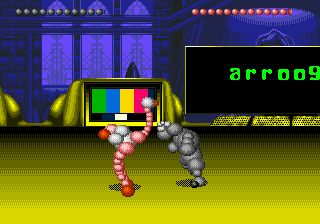 *Sigh. Yet another brawler that overly relies on a gimmick instead of solid gameplay. Hmm…gameplay. Now there’s an interesting word. Funny how it normally applies to fighting games, yet Ballz somehow manages to get around this tiny detail. I’m sure someone out there appreciates using three buttons to mindlessly smack their opponent into submission, but there are those of us that would like something a bit more complex. See, this is what you get when you have too much fun with the hardware and completely forget that those pretty visuals actually need to be wrapped around a game. There sure is a lot of eye candy here, and I love some of the pseudo 3D effects the developers managed to pull off. The problem is that Ballz stops being fun about three minutes in, after the senseless bashing loses its orbish charm. Who knows? Maybe there’s a code to unlock VectorMan as a playable character. Then he could kick everyone’s ass and proceed to demonstrate how to make a decent game.
*Sigh. Yet another brawler that overly relies on a gimmick instead of solid gameplay. Hmm…gameplay. Now there’s an interesting word. Funny how it normally applies to fighting games, yet Ballz somehow manages to get around this tiny detail. I’m sure someone out there appreciates using three buttons to mindlessly smack their opponent into submission, but there are those of us that would like something a bit more complex. See, this is what you get when you have too much fun with the hardware and completely forget that those pretty visuals actually need to be wrapped around a game. There sure is a lot of eye candy here, and I love some of the pseudo 3D effects the developers managed to pull off. The problem is that Ballz stops being fun about three minutes in, after the senseless bashing loses its orbish charm. Who knows? Maybe there’s a code to unlock VectorMan as a playable character. Then he could kick everyone’s ass and proceed to demonstrate how to make a decent game.
Beast Wrestler
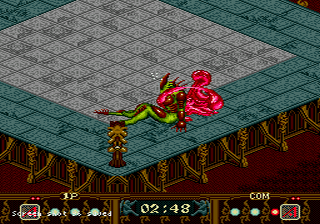 Ah Renovation. You were my favorite publisher on the Genesis after Sega, and I still mourn your death. My love for your catalogue is so great that I’m even willing to forgive you for Beast Wrestler. I bet you thought the concept was good enough, and I’m sure that by the time you realized that the game was far below your initial expectations, it was too late. Yes, I’m sure that’s what happened. That’s why the fighting engine is so broken. Maybe you had a strict deadline. That had to be it. You were rushed, so the game’s animation had to have less than three frames. Sure….um, yeah…Eh, and I’m pretty sure that your team was most likely understaffed, leading to a total lack of ideas to make what could have been a cool concept something more than a novelty with no redeeming qualities.
Ah Renovation. You were my favorite publisher on the Genesis after Sega, and I still mourn your death. My love for your catalogue is so great that I’m even willing to forgive you for Beast Wrestler. I bet you thought the concept was good enough, and I’m sure that by the time you realized that the game was far below your initial expectations, it was too late. Yes, I’m sure that’s what happened. That’s why the fighting engine is so broken. Maybe you had a strict deadline. That had to be it. You were rushed, so the game’s animation had to have less than three frames. Sure….um, yeah…Eh, and I’m pretty sure that your team was most likely understaffed, leading to a total lack of ideas to make what could have been a cool concept something more than a novelty with no redeeming qualities.
No, come to think of it, I can’t let this one slide Renovation, not after Syd of Valis. Shame on you.
Black Hole Assault
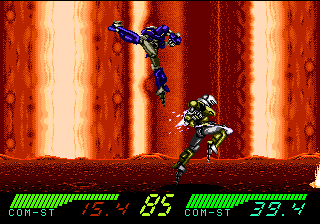 Those who dished out the $300+ for the Sega CD on launch day have some bittersweet memories of the games that were available. One of the early titles released was Black Hole Assault, the sequel to the incredibly mediocre Heavy Nova (scroll down if you simply can’t wait to read about that one). Essentially a cartridge game with a CD soundtrack, it boasted almost no improvements over the 8meg waste of plastic that was the original. Some more cut scenes attempt to make you care about the storyline, but the meager effort is completely squashed by the completely unresponsive gameplay. The characters themselves are just as bad, and in my opinion fighting with big robots should be much more fun than this. I suppose we can relieve Micronet of some of the blame, since Sega did a horrible job of supplying developers with Sega CD dev kits before launch. This caused heavily delays of any quality titles, so publishers simply tacked on CD audio to cart games. Even so, Black Hole Assault is bad enough on its own, and would have been the same even as a cart. Oh wait, it already was…
Those who dished out the $300+ for the Sega CD on launch day have some bittersweet memories of the games that were available. One of the early titles released was Black Hole Assault, the sequel to the incredibly mediocre Heavy Nova (scroll down if you simply can’t wait to read about that one). Essentially a cartridge game with a CD soundtrack, it boasted almost no improvements over the 8meg waste of plastic that was the original. Some more cut scenes attempt to make you care about the storyline, but the meager effort is completely squashed by the completely unresponsive gameplay. The characters themselves are just as bad, and in my opinion fighting with big robots should be much more fun than this. I suppose we can relieve Micronet of some of the blame, since Sega did a horrible job of supplying developers with Sega CD dev kits before launch. This caused heavily delays of any quality titles, so publishers simply tacked on CD audio to cart games. Even so, Black Hole Assault is bad enough on its own, and would have been the same even as a cart. Oh wait, it already was…
The Brutal Series
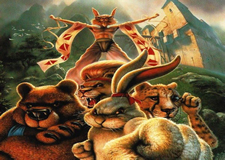 Animals beating the hell out each other has never been so much fun! That, at least, is your initial impression until you begin playing and realize just how damn hard these games are. All three versions, Genesis, Sega CD, and 32X, share the high learning curve that has made this series one of the more frustrating to play. Not that it’s on the same level as perhaps Eternal Champions (now that one was brutal), but it’s definitely up there. Takara tried to inject some humor into the whole thing, giving their characters such memorable names as “Tai Cheetah,” “Kung-Fu Bunny,” and my personal favorite, the “Dali Llama.” Don’t mistake the Warner Bros.-style animation for cute and cuddly, these animals will kick your ass without blinking twice. Still, it’s a very cool concept and all three games play exceptionally well. The Sega CD version stands out, with all the cool extras it has, such as the sound test, extra character, and FMV sequences (the good kind).
Animals beating the hell out each other has never been so much fun! That, at least, is your initial impression until you begin playing and realize just how damn hard these games are. All three versions, Genesis, Sega CD, and 32X, share the high learning curve that has made this series one of the more frustrating to play. Not that it’s on the same level as perhaps Eternal Champions (now that one was brutal), but it’s definitely up there. Takara tried to inject some humor into the whole thing, giving their characters such memorable names as “Tai Cheetah,” “Kung-Fu Bunny,” and my personal favorite, the “Dali Llama.” Don’t mistake the Warner Bros.-style animation for cute and cuddly, these animals will kick your ass without blinking twice. Still, it’s a very cool concept and all three games play exceptionally well. The Sega CD version stands out, with all the cool extras it has, such as the sound test, extra character, and FMV sequences (the good kind).
Clayfighter
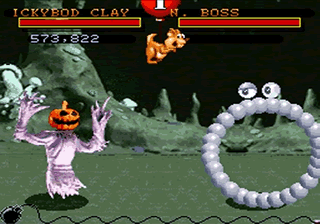 Ladies and gentlemen, what we have here is a failure to communicate. Communicate as in “actually transfer all those seemingly cool ideas in your head onto silicon.” Clayfighter looks nice, and the premise behind it is highly original. All that is sorrowfully lost once you pick up the controller. Stiff, unresponsive characters and some of the lamest moves around quickly deflate whatever expectations the opening scenes may have pumped up for you. I think that as we go back now and seriously analyze many of the games out there, what makes them stand the test of time isn’t their gimmick or graphics, but how well they were put together overall. What I’m sure seemed like something incredibly cool in 1993 is just sad today, and the designer’s intent to cover up their complete lack of fighting game knowledge with some impressive graphics is now utterly blatant. Some words of advice to would-be game designers: claymation figures do not work well in a fighting game engine. I don’t appreciate “button lag” when I try to attack. Apparently, I’m in the minority here, since Clayfighter got several sequels.
Ladies and gentlemen, what we have here is a failure to communicate. Communicate as in “actually transfer all those seemingly cool ideas in your head onto silicon.” Clayfighter looks nice, and the premise behind it is highly original. All that is sorrowfully lost once you pick up the controller. Stiff, unresponsive characters and some of the lamest moves around quickly deflate whatever expectations the opening scenes may have pumped up for you. I think that as we go back now and seriously analyze many of the games out there, what makes them stand the test of time isn’t their gimmick or graphics, but how well they were put together overall. What I’m sure seemed like something incredibly cool in 1993 is just sad today, and the designer’s intent to cover up their complete lack of fighting game knowledge with some impressive graphics is now utterly blatant. Some words of advice to would-be game designers: claymation figures do not work well in a fighting game engine. I don’t appreciate “button lag” when I try to attack. Apparently, I’m in the minority here, since Clayfighter got several sequels.
Cosmic Carnage
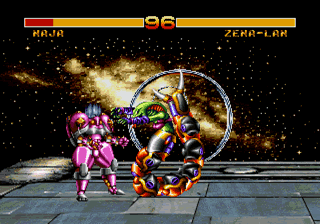 As soon as the 32X was announced, gamers eagerly began to imagine what a fighting game on the system would be like. This was back when the Street Fighter II craze was still in full effect, and the possibilities seemed pretty limitless, considering how much Sega was touting the new hardware. Imagine the surprise when Cosmic Carnage hit the shelves. Here was a game that neither took advantage of all the bells and whistles of 32-bits, nor did it retain the mandatory tight gameplay that makes fighters fun in the first place. Clunky, stiff characters with zero personality are almost unplayable with the stock three-button pad, and the range of moves is one step above sleep-inducing. The most that can be said in Cosmic Carnage‘s defense is that it was a victim of its own hype, as well as that of the novelty of a new system that never lived up to expectations. 32X gamers would finally get a decent fighter with AM2’s great port of Virtua Fighter later on, but it was too little, too late.
As soon as the 32X was announced, gamers eagerly began to imagine what a fighting game on the system would be like. This was back when the Street Fighter II craze was still in full effect, and the possibilities seemed pretty limitless, considering how much Sega was touting the new hardware. Imagine the surprise when Cosmic Carnage hit the shelves. Here was a game that neither took advantage of all the bells and whistles of 32-bits, nor did it retain the mandatory tight gameplay that makes fighters fun in the first place. Clunky, stiff characters with zero personality are almost unplayable with the stock three-button pad, and the range of moves is one step above sleep-inducing. The most that can be said in Cosmic Carnage‘s defense is that it was a victim of its own hype, as well as that of the novelty of a new system that never lived up to expectations. 32X gamers would finally get a decent fighter with AM2’s great port of Virtua Fighter later on, but it was too little, too late.
Deadly Moves
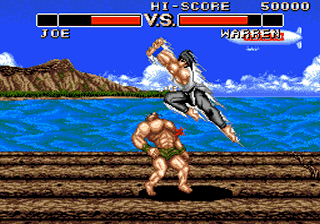 With everyone else jumping on the fighter bandwagon in 1992, Kaneko decided to throw its hat into the ring. What they gave us was Deadly Moves, which was neither original nor inspired. It was actually quite generic, with forgettable characters and sluggish gameplay. Though closer inspection may reveal that there were a couple of decent ideas that could have actually made the game something special, you come away shaking your head in disappointment. For example, multi-plane movement was possible, simply by moving the pad (no jumping or button presses required). The graphics aren’t that bad either.
With everyone else jumping on the fighter bandwagon in 1992, Kaneko decided to throw its hat into the ring. What they gave us was Deadly Moves, which was neither original nor inspired. It was actually quite generic, with forgettable characters and sluggish gameplay. Though closer inspection may reveal that there were a couple of decent ideas that could have actually made the game something special, you come away shaking your head in disappointment. For example, multi-plane movement was possible, simply by moving the pad (no jumping or button presses required). The graphics aren’t that bad either.
Sadly, that’s where the good is overwhelmed by the thoroughly mediocre. You can only choose from the cast in versus mode (single players must always use the awesomely-named Joe), and none of the supposedly “deadly” moves have virtually any impact behind them at all. Seriously, playing for only a few minutes leaves you wondering why you shouldn’t just move on to something else.
Double Dragon V: The Shadow Falls
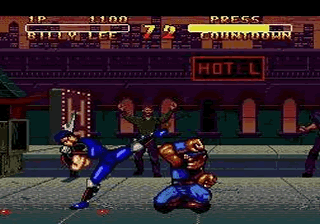 Ah, yet another of my favorite franchises raped in a shameless effort to cash in on the latest craze. Here is a game based on a cartoon that’s based on a game, and as you can probably guess, the result isn’t pretty. I need not mention how bad the cartoon was, but what really makes Double Dragon fans cringe is just how utterly bad this game is, cartoon inspiration aside. The classic gameplay has been traded in for a cheap one-on-one brawler, which would be passable, had the engine actually been good. Dark, goofy graphics only make the experience worse, and Tradewest has added insult to injury by mutilating the classic soundtrack the series is famous for. Why not follow Takara’s lead and port over the Neo Geo game, which isn’t as good as the originals, but is much better than this (and is quite underrated)? Nope, try as I might, I simply cannot find any redeeming features with this game, and don’t know whether to laugh or empathize with those poor souls that bought this for the Jaguar. At least the Genesis version was cheaper. Wait, that doesn’t make things better at all…
Ah, yet another of my favorite franchises raped in a shameless effort to cash in on the latest craze. Here is a game based on a cartoon that’s based on a game, and as you can probably guess, the result isn’t pretty. I need not mention how bad the cartoon was, but what really makes Double Dragon fans cringe is just how utterly bad this game is, cartoon inspiration aside. The classic gameplay has been traded in for a cheap one-on-one brawler, which would be passable, had the engine actually been good. Dark, goofy graphics only make the experience worse, and Tradewest has added insult to injury by mutilating the classic soundtrack the series is famous for. Why not follow Takara’s lead and port over the Neo Geo game, which isn’t as good as the originals, but is much better than this (and is quite underrated)? Nope, try as I might, I simply cannot find any redeeming features with this game, and don’t know whether to laugh or empathize with those poor souls that bought this for the Jaguar. At least the Genesis version was cheaper. Wait, that doesn’t make things better at all…
Dragonball Z
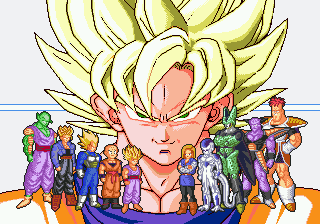 I think about the only console to not have a Dragonball Z fighter in its library is the Atari 2600 (and I may be wrong about that), so naturally the Mega Drive would have one. I’ve never been a big fan of the series, though I loved Akira Toriyama’s designs in Dragon Quest VIII (Shameless plug #3!), so I figured I’d give this one a try. Boy, am I glad I did. Fast and furious gameplay coupled with some great visuals is exactly the type of fighter the Mega Drive needed at the time, and I sometimes wonder if it would have been successful here in the U.S. We did get stranger Japanese games, so why not Dragonball?
I think about the only console to not have a Dragonball Z fighter in its library is the Atari 2600 (and I may be wrong about that), so naturally the Mega Drive would have one. I’ve never been a big fan of the series, though I loved Akira Toriyama’s designs in Dragon Quest VIII (Shameless plug #3!), so I figured I’d give this one a try. Boy, am I glad I did. Fast and furious gameplay coupled with some great visuals is exactly the type of fighter the Mega Drive needed at the time, and I sometimes wonder if it would have been successful here in the U.S. We did get stranger Japanese games, so why not Dragonball?
Perhaps the coolest feature here is the vertical split screen action when both fighters separate too much. This and the multi-plane movement give you a great sense of freedom that’s accentuated by the quick pace of the action. Pick any character you want – each with different orders of opponents – and forget the story, just kick some ass all over the place! Definitely worth picking up.
Dragon: Bruce Lee Story
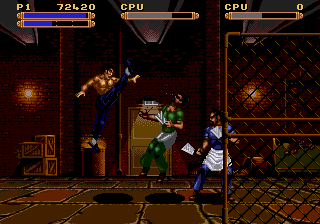 Despite the initial feeling of dread I experienced once the Acclaim logo came onscreen, I was a bit relieved to see that Virgin was involved. I guess they had a pretty fair amount of influence (pure speculation on my part), as the game turned out to be pretty decent for a licensed title. It closely follows the plot of the film (but it’s not exactly the same) and features gameplay that’s fun, despite the fact that battles can tend to drag on longer than they should. This is an unfortunate result of having to build up your Chi so slowly. Perhaps they should have taken a page from other, more popular fighters on how to properly implement a power bar. There are plenty of game modes from which to choose and the control is tight enough to make executing combinations and high impact moves simple and effective. It’s a shame that we all know how the story ends, since poor Bruce battles his little heart out here with such fervor and tenacity. It’s decent, but nothing special, though it does try harder than some of the other fighters released around the same time.
Despite the initial feeling of dread I experienced once the Acclaim logo came onscreen, I was a bit relieved to see that Virgin was involved. I guess they had a pretty fair amount of influence (pure speculation on my part), as the game turned out to be pretty decent for a licensed title. It closely follows the plot of the film (but it’s not exactly the same) and features gameplay that’s fun, despite the fact that battles can tend to drag on longer than they should. This is an unfortunate result of having to build up your Chi so slowly. Perhaps they should have taken a page from other, more popular fighters on how to properly implement a power bar. There are plenty of game modes from which to choose and the control is tight enough to make executing combinations and high impact moves simple and effective. It’s a shame that we all know how the story ends, since poor Bruce battles his little heart out here with such fervor and tenacity. It’s decent, but nothing special, though it does try harder than some of the other fighters released around the same time.
The Eternal Champions Series
 Perhaps the most famous fighting franchise on the Genesis, the Eternal Champions games need no introduction. They are all about challenge, and that is something which is delivered in spades. Famous for their gory and plentiful finishers, the series distinguished itself from other fighters by actually having a plot that goes beyond the standard “fighters from around the world gather to battle for the ultimate prize” that is a staple of the genre. While that dynamic is present to a degree, there are deep backstories for each fighter and the stakes for which they battle are cosmic…literally.
Perhaps the most famous fighting franchise on the Genesis, the Eternal Champions games need no introduction. They are all about challenge, and that is something which is delivered in spades. Famous for their gory and plentiful finishers, the series distinguished itself from other fighters by actually having a plot that goes beyond the standard “fighters from around the world gather to battle for the ultimate prize” that is a staple of the genre. While that dynamic is present to a degree, there are deep backstories for each fighter and the stakes for which they battle are cosmic…literally.
It’s a shame the third title, which was to be released on the Saturn, was canned so early in development. This is one trilogy that deserved to be finished.
The Fatal Fury Series
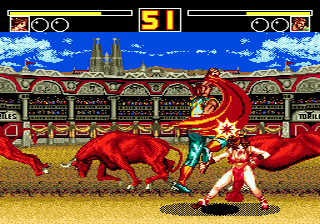 It’s surprising to see just how good a job Takara did with their Neo Geo ports. Sega owners were fortunate, and received a total of three Fatal Fury games (parts one and two, and Special), with the best one appearing on the Sega CD. I’ve always thought Fatal Fury was one of the cooler Neo Geo brands, and was quite happy to see them ported to my beloved Genesis, as I was in no financial condition to purchase an AES at the time (one of the problems of being a poor college student). Takara did an exceptional job with the conversions, and while a few understandable compromises had to be made for the hardware downgrade (no multi-plane movement in the first game), they’re pretty sound for having been squeezed onto such a small cartridge. I did notice that the Genesis versions play a bit more sluggishly, and purists are sure to point out how this hampers the gameplay in some fashion. Frankly, I’m not enough of a Fatal Fury connoisseur to know whether or not this is true. From what I’ve played of Fatal Fury Special on the Sega CD, it appears to be the most complete, though it’s become a bit rare these days. The enhanced backgrounds and the Dolby surround support are nice, and round out a really great package overall.
It’s surprising to see just how good a job Takara did with their Neo Geo ports. Sega owners were fortunate, and received a total of three Fatal Fury games (parts one and two, and Special), with the best one appearing on the Sega CD. I’ve always thought Fatal Fury was one of the cooler Neo Geo brands, and was quite happy to see them ported to my beloved Genesis, as I was in no financial condition to purchase an AES at the time (one of the problems of being a poor college student). Takara did an exceptional job with the conversions, and while a few understandable compromises had to be made for the hardware downgrade (no multi-plane movement in the first game), they’re pretty sound for having been squeezed onto such a small cartridge. I did notice that the Genesis versions play a bit more sluggishly, and purists are sure to point out how this hampers the gameplay in some fashion. Frankly, I’m not enough of a Fatal Fury connoisseur to know whether or not this is true. From what I’ve played of Fatal Fury Special on the Sega CD, it appears to be the most complete, though it’s become a bit rare these days. The enhanced backgrounds and the Dolby surround support are nice, and round out a really great package overall.
Fighting Masters
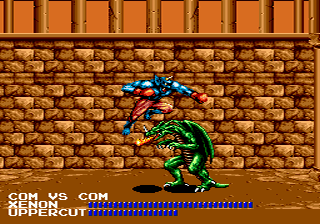 I like the premise in Fighting Masters. Having twelve planets fight a mano-a-mano contest to see who will be allowed to survive their sun going super nova is a nice creative touch. Hey, know what? I just discussed the best part of this game! The rest is very middle-of-the-road, though I do feel that they should have named this one Jump High as Hell and Slam The Other Guy to Death. Yes. Yes, that would have been more fitting I think. There is little actual “fighting,” and combos are almost nowhere to be seen, but the high flying throws and body slams are actually pretty cool. There isn’t much at all in the way of presentation, but would you actually expect some from a 1992 fighter by Treco? As long as you’re not looking for something deep, Fighting Masters might be worth a bit of play if you can find it cheap (and there’s no reason why you shouldn’t be able to). Just don’t expect to be occupied for too long, since the gameplay isn’t enough to really keep you tied down. However, I found myself playing for much longer than I initially thought I would, so your mileage will definitely vary here.
I like the premise in Fighting Masters. Having twelve planets fight a mano-a-mano contest to see who will be allowed to survive their sun going super nova is a nice creative touch. Hey, know what? I just discussed the best part of this game! The rest is very middle-of-the-road, though I do feel that they should have named this one Jump High as Hell and Slam The Other Guy to Death. Yes. Yes, that would have been more fitting I think. There is little actual “fighting,” and combos are almost nowhere to be seen, but the high flying throws and body slams are actually pretty cool. There isn’t much at all in the way of presentation, but would you actually expect some from a 1992 fighter by Treco? As long as you’re not looking for something deep, Fighting Masters might be worth a bit of play if you can find it cheap (and there’s no reason why you shouldn’t be able to). Just don’t expect to be occupied for too long, since the gameplay isn’t enough to really keep you tied down. However, I found myself playing for much longer than I initially thought I would, so your mileage will definitely vary here.
Heavy Nova
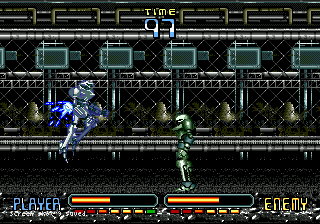 Blech. This early attempt at a robotic brawler is a perfect example of what I was talking about in this article’s opening statement. Gameplay is simply horrible, and the graphics aren’t that far behind, though there are some decent backgrounds. About the only redeeming feature of Heavy Nova is its excellent soundtrack. Again, I don’t hold it against Micronet, since I’m sure no one there at the time had any real experience making fighting games. I can accept the lacking visuals (pretty cut scenes though), and I can even understand the dull gameplay. What I don’t understand is why these people were allowed a second attempt (see the earlier entry of Black Hole Assault). The special moves are laughable, and the platform element that tried so hard to stand out only comes across as half-assed. One bad effort is enough, and when Cyborg Justice stands as king among bad robot games, it’s mainly because of turds like this.
Blech. This early attempt at a robotic brawler is a perfect example of what I was talking about in this article’s opening statement. Gameplay is simply horrible, and the graphics aren’t that far behind, though there are some decent backgrounds. About the only redeeming feature of Heavy Nova is its excellent soundtrack. Again, I don’t hold it against Micronet, since I’m sure no one there at the time had any real experience making fighting games. I can accept the lacking visuals (pretty cut scenes though), and I can even understand the dull gameplay. What I don’t understand is why these people were allowed a second attempt (see the earlier entry of Black Hole Assault). The special moves are laughable, and the platform element that tried so hard to stand out only comes across as half-assed. One bad effort is enough, and when Cyborg Justice stands as king among bad robot games, it’s mainly because of turds like this.
Justice League Task Force
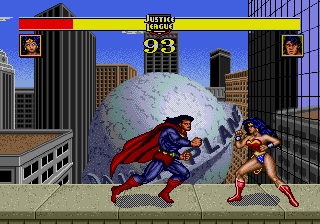 Holy rip offs Batman! As you can probably tell from the games on this list so far, most are nothing more than generic cash runs designed to fool you into thinking you’d bought the next Street Fighter. Justice League Task Force appears to be most shameless of all, using some of the world’s greatest heroes to take each other on in what should have been an awesome slugfest of cosmic proportions. Instead, we got things like Batman taking on Superman and possibly winning, and some of the worst character choices imaginable. What? you mean you’d actually consider playing as Cheetah or Despero? How about Aquaman? Fucking Aquaman! Where’s Green Lantern? Doomsday? Captain Marvel? If the roster weren’t bad enough, the gameplay is utter ass. Cheap A.I. and frustrating move combinations make playing a chore. I’m a big super hero fan to be sure, and this just makes me mad. To think that we had to wait all the way until X-Men: Children of the Atom for a decent comic fighter. Sheesh. Thanks for nothing Sunsoft, You just had to go and partner up with Acclaim, didn’t you?
Holy rip offs Batman! As you can probably tell from the games on this list so far, most are nothing more than generic cash runs designed to fool you into thinking you’d bought the next Street Fighter. Justice League Task Force appears to be most shameless of all, using some of the world’s greatest heroes to take each other on in what should have been an awesome slugfest of cosmic proportions. Instead, we got things like Batman taking on Superman and possibly winning, and some of the worst character choices imaginable. What? you mean you’d actually consider playing as Cheetah or Despero? How about Aquaman? Fucking Aquaman! Where’s Green Lantern? Doomsday? Captain Marvel? If the roster weren’t bad enough, the gameplay is utter ass. Cheap A.I. and frustrating move combinations make playing a chore. I’m a big super hero fan to be sure, and this just makes me mad. To think that we had to wait all the way until X-Men: Children of the Atom for a decent comic fighter. Sheesh. Thanks for nothing Sunsoft, You just had to go and partner up with Acclaim, didn’t you?
Ka-Ge-Ki
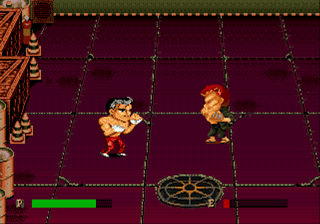 Writing about video games isn’t always fun and excitement. For every incredibly innovative and entertaining game, there’s a Ka-Ge-Ki. By far one of the worst fighters ever brought to console, Sage’s Creation’s silicon nightmare is the green stuff at the bottom of the Genesis fighter barrel. Horrible graphics, nearly non-existent sound, and simply abysmal gameplay all contribute to a prime example of how not to cash in on a gaming craze. It was games like this that set the fighting genre back years and kept Capcom laughing all the way to the bank due to lack of competition. Yes, I honestly think that Ka-Ge-Ki caused irreparable harm to the industry, for which its creators should be flogged and quartered.
Writing about video games isn’t always fun and excitement. For every incredibly innovative and entertaining game, there’s a Ka-Ge-Ki. By far one of the worst fighters ever brought to console, Sage’s Creation’s silicon nightmare is the green stuff at the bottom of the Genesis fighter barrel. Horrible graphics, nearly non-existent sound, and simply abysmal gameplay all contribute to a prime example of how not to cash in on a gaming craze. It was games like this that set the fighting genre back years and kept Capcom laughing all the way to the bank due to lack of competition. Yes, I honestly think that Ka-Ge-Ki caused irreparable harm to the industry, for which its creators should be flogged and quartered.
The whole game is little more than an exercise in repetitiveness. You have two punches, one fast and a powerful jab, and every level consists of two thugs and a boss. I’m serious, that’s it. Beat two pathetic goons, kill the boss, and then it’s on to the next level. Thankfully, the game is very short and easy, which means your suffering won’t be long lasting.
The King of the Monsters Series
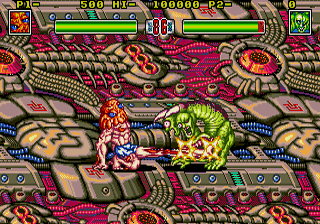 Considered a classic on the Neo Geo, both installments of the series eventually made their way onto the Genesis, albeit without the massive sprites and impressive audio. What made it intact? The gameplay did, for the most part. Although the original has been stripped down a bit so as to fit onto Sega’s 16-bit wonder (two characters were lost), the sequel is widely regarded to be on par with the arcade version, if not superior. The move set has been improved, and grapples are no longer random. Plus, using a six-button controller greatly reduces the amount of button mashing you’ll be doing.
Considered a classic on the Neo Geo, both installments of the series eventually made their way onto the Genesis, albeit without the massive sprites and impressive audio. What made it intact? The gameplay did, for the most part. Although the original has been stripped down a bit so as to fit onto Sega’s 16-bit wonder (two characters were lost), the sequel is widely regarded to be on par with the arcade version, if not superior. The move set has been improved, and grapples are no longer random. Plus, using a six-button controller greatly reduces the amount of button mashing you’ll be doing.
Probably the biggest change from the arcade version is that the games are now strictly one-on-one fighters. The short, side scrolling stages have been changed, and while I’m not entirely in favor of it, the improvements to the gameplay more than make up for it.
Mighty Morphin’ Power Rangers
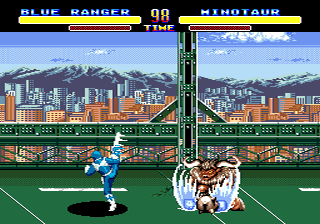 Toss a group of teenagers in fruity suits together with some big, alien monsters and watch the fur fly! The Power Rangers have been around a lot longer than most people might think they deserve, but one thing that you can’t argue with is the power of the license. The Genesis fell victim to its power three times (the third via the Sega CD), and it’s a pleasant surprise how decent they turned out. Most license games well…suck, and the Power Rangers are a lot better than most. This first release is arguably the weakest of the bunch, and falls into the generic bin as far as Genesis fighters go. It’s not that the game is bad – which it isn’t, but I can’t really find anything to make it stand out from the crowd aside from the license. Megazord is there, there’s a decent selection of characters available, and the visuals and control are decent enough. It won’t set the world on fire, but fans of the series will undoubtedly enjoy it, and fighting fans will find something to fill an afternoon, if nothing else.
Toss a group of teenagers in fruity suits together with some big, alien monsters and watch the fur fly! The Power Rangers have been around a lot longer than most people might think they deserve, but one thing that you can’t argue with is the power of the license. The Genesis fell victim to its power three times (the third via the Sega CD), and it’s a pleasant surprise how decent they turned out. Most license games well…suck, and the Power Rangers are a lot better than most. This first release is arguably the weakest of the bunch, and falls into the generic bin as far as Genesis fighters go. It’s not that the game is bad – which it isn’t, but I can’t really find anything to make it stand out from the crowd aside from the license. Megazord is there, there’s a decent selection of characters available, and the visuals and control are decent enough. It won’t set the world on fire, but fans of the series will undoubtedly enjoy it, and fighting fans will find something to fill an afternoon, if nothing else.
The Mortal Kombat Series
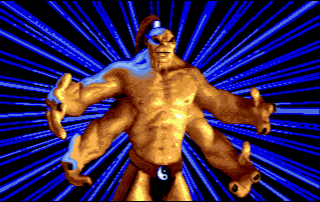 Some say that the level of infamy and controversy that the Mortal Kombat games have received is unfounded, and that may well be true, compared to today’s games. Back in the day, however, there was enough here to warrant a full-fledged senate investigation, which resulted in the game industry adopting its own rating system. Street Fighter can’t say that about itself, now can it? Though the first game was the most public, with all its blood and violence intact from the arcade original, the sequel received little fanfare (as well it should, considering that the SNES version stomps all over it). By the time the third installment rolled around, everyone was pretty used to exposed organs and sudden decapitations. Gore only goes so far, but luckily the games had the gameplay and secrets to keep gamers interested once the novelty wore off. Though released on the Sega CD with clearer voice and better graphics, it is the cartridge version of the first Mortal Kombat game that gamers remember most. FINISH HIM!
Some say that the level of infamy and controversy that the Mortal Kombat games have received is unfounded, and that may well be true, compared to today’s games. Back in the day, however, there was enough here to warrant a full-fledged senate investigation, which resulted in the game industry adopting its own rating system. Street Fighter can’t say that about itself, now can it? Though the first game was the most public, with all its blood and violence intact from the arcade original, the sequel received little fanfare (as well it should, considering that the SNES version stomps all over it). By the time the third installment rolled around, everyone was pretty used to exposed organs and sudden decapitations. Gore only goes so far, but luckily the games had the gameplay and secrets to keep gamers interested once the novelty wore off. Though released on the Sega CD with clearer voice and better graphics, it is the cartridge version of the first Mortal Kombat game that gamers remember most. FINISH HIM!
Pit-Fighter
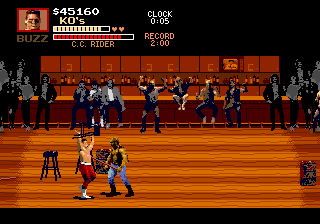 Oh me, oh my. Look what we have here! Just when I thought I had laughed my ass off completely in the arcades all those years ago, here comes Tengen to take away what little I have left. The digitized characters were stiff and clunky in the original, and they fare no better on the Genesis. Stripped of much of its animation, the game’s colors are also severely washed out and pixilated. To further remove it from any of the coin-op’s redeeming qualities, the camera has been dropped back almost to the nose bleed section, and the zoom has been eliminated entirely. Yes folks, this is the best example of how to further butcher an already crappy arcade fighter since Primal Rage. Chop up the product, let it sit in the blazing sun for several hours, then stuff it in a closet for a few days! Remove and play! Yum!
Oh me, oh my. Look what we have here! Just when I thought I had laughed my ass off completely in the arcades all those years ago, here comes Tengen to take away what little I have left. The digitized characters were stiff and clunky in the original, and they fare no better on the Genesis. Stripped of much of its animation, the game’s colors are also severely washed out and pixilated. To further remove it from any of the coin-op’s redeeming qualities, the camera has been dropped back almost to the nose bleed section, and the zoom has been eliminated entirely. Yes folks, this is the best example of how to further butcher an already crappy arcade fighter since Primal Rage. Chop up the product, let it sit in the blazing sun for several hours, then stuff it in a closet for a few days! Remove and play! Yum!
Power Instinct
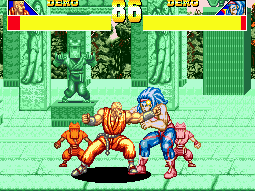 I think that Power Instinct will go down in history as the first and perhaps only fighting game to have a karaoke mode. That alone makes it worth the price of admission! Once you’re done with that, there’s still some fun to be had here. power Instinct has a decent amount of play modes, including a story mode. However, since the game is in Japanese, you might not get as much out of it as you should. Still, the main focus of a fighter is to whup ass, right? So jump right into the battle royal mode, which lets you and a friend pit up to eight fighters each in a free-for-all. There’s also the standard versus mode, and the depth Atlus (yes, that Atlus) provided is backed up by a pretty solid engine. The game has a certain Fatal fury feel to it – to me, at least – and though nothing mind blowing, it’s still a lot of fun to play. In the end, that’s what counts, and I’m surprised that Atlus didn’t follow up on Power Instinct with more fighters. I guess they sensed that the RPG genre had more meat to it.
I think that Power Instinct will go down in history as the first and perhaps only fighting game to have a karaoke mode. That alone makes it worth the price of admission! Once you’re done with that, there’s still some fun to be had here. power Instinct has a decent amount of play modes, including a story mode. However, since the game is in Japanese, you might not get as much out of it as you should. Still, the main focus of a fighter is to whup ass, right? So jump right into the battle royal mode, which lets you and a friend pit up to eight fighters each in a free-for-all. There’s also the standard versus mode, and the depth Atlus (yes, that Atlus) provided is backed up by a pretty solid engine. The game has a certain Fatal fury feel to it – to me, at least – and though nothing mind blowing, it’s still a lot of fun to play. In the end, that’s what counts, and I’m surprised that Atlus didn’t follow up on Power Instinct with more fighters. I guess they sensed that the RPG genre had more meat to it.
Primal Rage
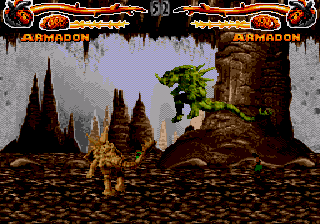 To this day it still puzzles me as to how Primal Rage could ever have a fan base, yet it does. The premise is highly transparent (hmm, who haven’t we pitted against each other? I know! Dinosaurs!), and the gameplay is a button masher’s wet dream. Using digitized stop motion animation, it had some potential; however, the gameplay didn’t match the creativity of the presentation. Eating terrified cavemen was pretty cool, although Midway’s own Rampage did that first, but the fighting was just too stiff to allow any implementation of strategy. Even knowing the moves, most battles degrade into “who hits the buttons the fastest.” Mortal Kombat at least permitted you to execute your combos easily enough. I seem to be in the minority here though, since Primal Rage made an appearance on just about every console out there. My hope for humanity has never been the same.
To this day it still puzzles me as to how Primal Rage could ever have a fan base, yet it does. The premise is highly transparent (hmm, who haven’t we pitted against each other? I know! Dinosaurs!), and the gameplay is a button masher’s wet dream. Using digitized stop motion animation, it had some potential; however, the gameplay didn’t match the creativity of the presentation. Eating terrified cavemen was pretty cool, although Midway’s own Rampage did that first, but the fighting was just too stiff to allow any implementation of strategy. Even knowing the moves, most battles degrade into “who hits the buttons the fastest.” Mortal Kombat at least permitted you to execute your combos easily enough. I seem to be in the minority here though, since Primal Rage made an appearance on just about every console out there. My hope for humanity has never been the same.
Rise of the Robots
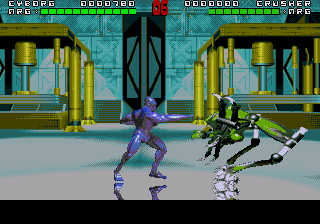 Check out those rendered graphics? Pretty sharp, huh? With looks like those Rise of the Robots must be a simply incredible fighting game. After all, graphics make the game, right? What? You say Acclaim published this one? Great! I simply can’t think of a better game to play than a fighting game with awesome visuals and completely broken gameplay. Acclaim has been known for some awesome titles and is renowned for its innovation, but the creation of a fighter that doesn’t even let you jump over your opponent has to be one of the coolest ideas ever conceived! Why, such was the goodness of Rise of the Robots that we were treated…nay, privileged to a sequel on the Saturn and Playstation later on. That’s how much Acclaim loves its fans, and it’s games like this that are a true testament of their total grasp of what gamers want to play. It’s no wonder that….that they….*snap!*……can’t continue…..*pop!*…sarcasm meter overloading…*BOOM!*……
Check out those rendered graphics? Pretty sharp, huh? With looks like those Rise of the Robots must be a simply incredible fighting game. After all, graphics make the game, right? What? You say Acclaim published this one? Great! I simply can’t think of a better game to play than a fighting game with awesome visuals and completely broken gameplay. Acclaim has been known for some awesome titles and is renowned for its innovation, but the creation of a fighter that doesn’t even let you jump over your opponent has to be one of the coolest ideas ever conceived! Why, such was the goodness of Rise of the Robots that we were treated…nay, privileged to a sequel on the Saturn and Playstation later on. That’s how much Acclaim loves its fans, and it’s games like this that are a true testament of their total grasp of what gamers want to play. It’s no wonder that….that they….*snap!*……can’t continue…..*pop!*…sarcasm meter overloading…*BOOM!*……
Samurai Shodown
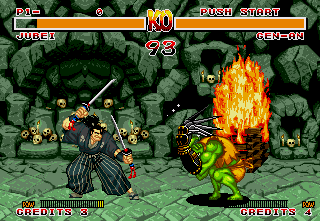 The third in SNK/Takara’s fighting game quartet on the Genesis, Samurai Shodown is probably the best of the bunch. The characters are wonderful, and the gameplay is incredible. The Genesis version has taken a hit both graphically and audio-wise, and the zoom is gone (thank God! The SNES version’s zoom made me nauseous), but the meat of the game is present and ready to kick some ass. Purists will undoubtedly go for the AES or MVS cart, but those of us without big bank accounts can always play the Sega CD version, which is almost perfect, save for some load times. The redbook audio is especially nice! I’ve heard some people comment on how SNK has run this series into the ground, and most tend to favor part two as the best. The original is still a blast to play, and holds up quite well on 16-bit hardware.
The third in SNK/Takara’s fighting game quartet on the Genesis, Samurai Shodown is probably the best of the bunch. The characters are wonderful, and the gameplay is incredible. The Genesis version has taken a hit both graphically and audio-wise, and the zoom is gone (thank God! The SNES version’s zoom made me nauseous), but the meat of the game is present and ready to kick some ass. Purists will undoubtedly go for the AES or MVS cart, but those of us without big bank accounts can always play the Sega CD version, which is almost perfect, save for some load times. The redbook audio is especially nice! I’ve heard some people comment on how SNK has run this series into the ground, and most tend to favor part two as the best. The original is still a blast to play, and holds up quite well on 16-bit hardware.
Shaq Fu
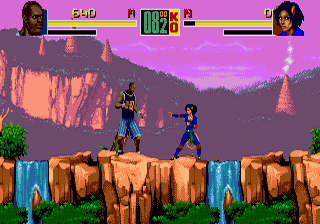 Games centered around sports stars are usually a bad thing, unless they’re actually, you know, sports games. When developers decide to place athletes in situations that are totally unreal and inconceivable, things tend to get nasty. The SNES has the eternal shame of being the home to Michael Jordan’s Chaos in the Windy City, and I suspect that its burden was so great that it decided to share Shaq Fu with us Genesis owners. Picture if you will, a fighting game about Shaquille O’Neil. Now, think about that for a second. Shaq…in a fighting game. A basketball game? Sure. A rap simulation? Perhaps. But a fighting game? I’d be more inclined to accept this line of thinking if Shaq actually fought somewhere. On the court, at concerts, anywhere; as long as he actually whupped some ass. Sadly, Shaq Fu the game plays much like Shaq the man raps: sluggishly, unconvincingly, and with about as much heart as Martha Stewart. Too bad its horrible cover didn’t share the Madden curse. now there’s something I could get behind.
Games centered around sports stars are usually a bad thing, unless they’re actually, you know, sports games. When developers decide to place athletes in situations that are totally unreal and inconceivable, things tend to get nasty. The SNES has the eternal shame of being the home to Michael Jordan’s Chaos in the Windy City, and I suspect that its burden was so great that it decided to share Shaq Fu with us Genesis owners. Picture if you will, a fighting game about Shaquille O’Neil. Now, think about that for a second. Shaq…in a fighting game. A basketball game? Sure. A rap simulation? Perhaps. But a fighting game? I’d be more inclined to accept this line of thinking if Shaq actually fought somewhere. On the court, at concerts, anywhere; as long as he actually whupped some ass. Sadly, Shaq Fu the game plays much like Shaq the man raps: sluggishly, unconvincingly, and with about as much heart as Martha Stewart. Too bad its horrible cover didn’t share the Madden curse. now there’s something I could get behind.
Slaughter Sport
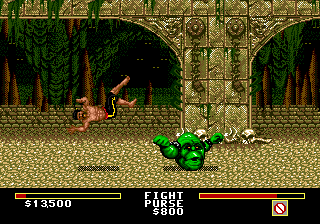 Does anyone remember exactly how many name changes this game went through before finally being released to the unabashed disinterest of the Genesis community? Let’s see! It was originally supposed to be called Red Belt but was written for the PC as Tongue of the Fatman. It then appeared on the Commodore 64 as Mondu’s Fight Palace and was eventually released on the Genesis as Slaughter Sport. Quite an odyssey. Since its original unveiling on a Genesis poster in 1990, it underwent several changes and improvements, sadly none of which actually made it any fun to play. Supposedly, it features variant versions of each song, and will change every time you play. Too bad the gameplay couldn’t change to actually become fun. The whole “bet on your own life” concept was incredibly innovative back in the day and would even be cool today. The fighting just wasn’t able to back it up.
Does anyone remember exactly how many name changes this game went through before finally being released to the unabashed disinterest of the Genesis community? Let’s see! It was originally supposed to be called Red Belt but was written for the PC as Tongue of the Fatman. It then appeared on the Commodore 64 as Mondu’s Fight Palace and was eventually released on the Genesis as Slaughter Sport. Quite an odyssey. Since its original unveiling on a Genesis poster in 1990, it underwent several changes and improvements, sadly none of which actually made it any fun to play. Supposedly, it features variant versions of each song, and will change every time you play. Too bad the gameplay couldn’t change to actually become fun. The whole “bet on your own life” concept was incredibly innovative back in the day and would even be cool today. The fighting just wasn’t able to back it up.
The Street Fighter Series
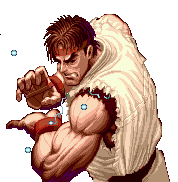 I know I’m going to get blasted for this, but I prefer Special Champion Edition over Super Street Fighter II. Why? Two reasons. First, The gameplay seems tighter and more fluid. Second, the sound is less garbled and the music isn’t as tinny. I also tend to wonder where the extra eight megs went (SSF II is a whopping 40 megs, the largest game on the Genesis), compared to the SNES version. That said, both games are deserving of playtime (yes, I own them both), and the tournament modes are enough to keep old school gamers beating each other senseless for quite a while. Since I absolutely suck at Street Fighter II, I actually find these games more appealing than the 400-hit, air juggle, super special, mega ultra crush combo gameplay of the later VS. games Capcom released. Bison is still a bastard, and Chun-Li is as predictable as ever. Gotta love those early fighters!
I know I’m going to get blasted for this, but I prefer Special Champion Edition over Super Street Fighter II. Why? Two reasons. First, The gameplay seems tighter and more fluid. Second, the sound is less garbled and the music isn’t as tinny. I also tend to wonder where the extra eight megs went (SSF II is a whopping 40 megs, the largest game on the Genesis), compared to the SNES version. That said, both games are deserving of playtime (yes, I own them both), and the tournament modes are enough to keep old school gamers beating each other senseless for quite a while. Since I absolutely suck at Street Fighter II, I actually find these games more appealing than the 400-hit, air juggle, super special, mega ultra crush combo gameplay of the later VS. games Capcom released. Bison is still a bastard, and Chun-Li is as predictable as ever. Gotta love those early fighters!
Street Smart
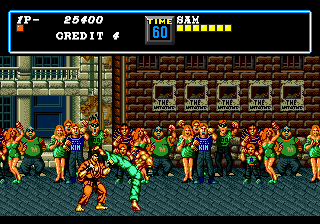 Horrible, simply horrible. These are more than enough words to describe how Street Smart plays. You’d think that a pre-Street Fighter II fighter would at least have been playable. No, unlike some of the better offerings from companies such as Data East and Konami, Treco’s Street Smart was only too happy to toss generic characters against each other, regardless of whether or not they could actually fight. To hell with gameplay! Forget originality! These characters look cool! Unfortunately, the completely boorish gameplay (a handful of pitiful moves!) and repetitiveness make this one to be avoided. I understand that Treco wasn’t exactly known for its great fighters, but this is a bit too much.
Horrible, simply horrible. These are more than enough words to describe how Street Smart plays. You’d think that a pre-Street Fighter II fighter would at least have been playable. No, unlike some of the better offerings from companies such as Data East and Konami, Treco’s Street Smart was only too happy to toss generic characters against each other, regardless of whether or not they could actually fight. To hell with gameplay! Forget originality! These characters look cool! Unfortunately, the completely boorish gameplay (a handful of pitiful moves!) and repetitiveness make this one to be avoided. I understand that Treco wasn’t exactly known for its great fighters, but this is a bit too much.
I could forgive Street Smart‘s simplicity were it actually fun to play. A meager attempt at depth is made by allowing you to customize your stats after each fight, as well as bet on yourself or your opponent, but the action is just not enough to make the whole exercise worth it. One to pass on, my friends.
TMNT Tournament Fighters
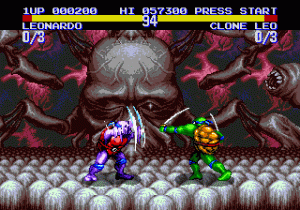 After a seemingly endless deluge of beat-’em-ups, Konami decided to try something different with the Ninja Turtles franchise, which was waning in popularity. Since the characters naturally lend themselves to fighting, why not make it a full-fledged one-on-one brawler? The result was Tournament Fighters, which was released on both the Genesis and SNES. Sega fans got the inferior of the two, and while the game plays well enough on the Genesis, it simply cannot match up to the tighter control and great presentation of the SNES version. Comparatively darker than the standard Turtles game, Tournament Fighters tries to take the franchise in the direction that diehard fans wanted to see all along: that of the classic Mirage Studios comic book. Well, Konami got the looks down pat, but they seem to have left out a little something called gameplay, which is kind of important in a fighting game. Not that the Genesis rendition is bad per se, just that it doesn’t play as well as it does on the SNES, even with the yummy six-button Genesis pad. Still it’s a decent enough romp for a while, and fans are sure to play it regardless.
After a seemingly endless deluge of beat-’em-ups, Konami decided to try something different with the Ninja Turtles franchise, which was waning in popularity. Since the characters naturally lend themselves to fighting, why not make it a full-fledged one-on-one brawler? The result was Tournament Fighters, which was released on both the Genesis and SNES. Sega fans got the inferior of the two, and while the game plays well enough on the Genesis, it simply cannot match up to the tighter control and great presentation of the SNES version. Comparatively darker than the standard Turtles game, Tournament Fighters tries to take the franchise in the direction that diehard fans wanted to see all along: that of the classic Mirage Studios comic book. Well, Konami got the looks down pat, but they seem to have left out a little something called gameplay, which is kind of important in a fighting game. Not that the Genesis rendition is bad per se, just that it doesn’t play as well as it does on the SNES, even with the yummy six-button Genesis pad. Still it’s a decent enough romp for a while, and fans are sure to play it regardless.
Time Killers
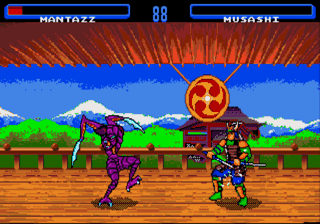 Anyone who’s been playing fighting games longer than a few years remembers Time Killers, perhaps the greatest offender of milking the Mortal Kombat violence craze. Gamers were initially enthralled at the prospect of ripping off an opponent’s limb and watching him fight while blood poured from the wound, but soon became disenchanted once the novelty wore off. See, Time Killers, for all its guts and blood, had a single, fatal flaw: it played like shit. The stiffness of the animation made executing moves much more difficult than necessary, a huge problem when the control wasn’t so good to begin with. Traveling through time to defeat multiple opponents wasn’t such an original concept either, as Eternal Champions did it much, much better. I do have to admit that severing all a foe’s arms and legs, leaving him dragging himself on the floor, was pretty cool for a while. Of course, once you get over that there really is no reason to keep playing. The presentation is as bad as the gameplay, and the characters are laughable. The name does fit, as you’ll be wondering why you spent any time at all playing this turd.
Anyone who’s been playing fighting games longer than a few years remembers Time Killers, perhaps the greatest offender of milking the Mortal Kombat violence craze. Gamers were initially enthralled at the prospect of ripping off an opponent’s limb and watching him fight while blood poured from the wound, but soon became disenchanted once the novelty wore off. See, Time Killers, for all its guts and blood, had a single, fatal flaw: it played like shit. The stiffness of the animation made executing moves much more difficult than necessary, a huge problem when the control wasn’t so good to begin with. Traveling through time to defeat multiple opponents wasn’t such an original concept either, as Eternal Champions did it much, much better. I do have to admit that severing all a foe’s arms and legs, leaving him dragging himself on the floor, was pretty cool for a while. Of course, once you get over that there really is no reason to keep playing. The presentation is as bad as the gameplay, and the characters are laughable. The name does fit, as you’ll be wondering why you spent any time at all playing this turd.
Ultraman
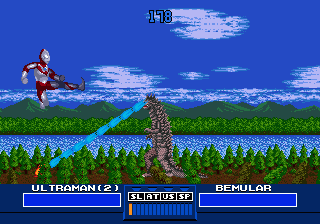 I used to love the old Ultraman shows on TV. There’s nothing like grown men in rubber suits smashing models to get a young boy excited. There have been many games featuring the huge hero on a myriad of platforms, but this is the only one to see daylight on the Mega Drive. It’s almost the same as the Ultraman title that was released close to the SNES launch, and this is noticeable almost instantly. In the nearly two years it took to make the platform jump, nothing has really been changed, and what we get is a stale version of an already mediocre fighter. You can’t really make your brawler too deep with only three buttons, and the game’s shallowness is something that was quite common in Genesis fighting games of the period. Everyone wanted the next big thing but weren’t willing to put in the time and effort needed to create such a polished product. I guess this is fine if you’re into Japanese monster flicks or are an Ultraman fan in general, but serious fighting fans should look elsewhere.
I used to love the old Ultraman shows on TV. There’s nothing like grown men in rubber suits smashing models to get a young boy excited. There have been many games featuring the huge hero on a myriad of platforms, but this is the only one to see daylight on the Mega Drive. It’s almost the same as the Ultraman title that was released close to the SNES launch, and this is noticeable almost instantly. In the nearly two years it took to make the platform jump, nothing has really been changed, and what we get is a stale version of an already mediocre fighter. You can’t really make your brawler too deep with only three buttons, and the game’s shallowness is something that was quite common in Genesis fighting games of the period. Everyone wanted the next big thing but weren’t willing to put in the time and effort needed to create such a polished product. I guess this is fine if you’re into Japanese monster flicks or are an Ultraman fan in general, but serious fighting fans should look elsewhere.
Virtua Fighter
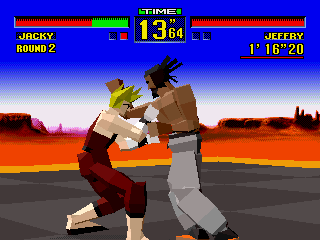 When originally announced, many skeptics felt that there was no way the 32X could mimic the power of Sega’s monstrous Model 1 board. Surely the mushroom-shaped add-on would fall well short of producing a decent port of Virtua Fighter, especially in its presentation. The collective silence that befell these naysayers upon the game’s release was quite deafening, considering that the 32X version not only holds its own but actually surpasses the Saturn rendition in several areas. It features twice as many modes of play as its CD cousin, and while its graphics aren’t as detailed, they’re more solid and don’t suffer from as much flicker. The sound took a hit….ok, it took a severe gang beating, but everything else is very solid. Just about everyone with a Saturn has a copy lying around, but I still recommend getting the 32X cart. It’s almost an obligation to pad one’s 32X library, so why not add a game that’s actually worth having?
When originally announced, many skeptics felt that there was no way the 32X could mimic the power of Sega’s monstrous Model 1 board. Surely the mushroom-shaped add-on would fall well short of producing a decent port of Virtua Fighter, especially in its presentation. The collective silence that befell these naysayers upon the game’s release was quite deafening, considering that the 32X version not only holds its own but actually surpasses the Saturn rendition in several areas. It features twice as many modes of play as its CD cousin, and while its graphics aren’t as detailed, they’re more solid and don’t suffer from as much flicker. The sound took a hit….ok, it took a severe gang beating, but everything else is very solid. Just about everyone with a Saturn has a copy lying around, but I still recommend getting the 32X cart. It’s almost an obligation to pad one’s 32X library, so why not add a game that’s actually worth having?
Virtua Fighter 2
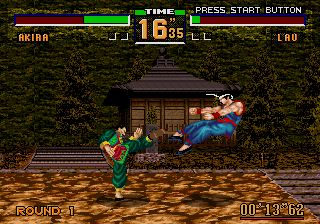 I must say that upon first booting up Virtua Fighter 2, I was impressed. The gameplay was surprisingly present, given not only the downgrade in raw processing power, but also from making the transition from 3D to 2D. The graphics were very detailed and clear, and even the music was pretty close to the original material. There’s just one problem, Virtua Fighter‘s strategy is all but lost in two dimensions, and the game has been reduced to a simple punch/kick mash fest. No dodging makes counters a thing of the past, and many of the moves lacked the polish and impact (no pun intended) they had on the Saturn and in the arcade. Moreover, the arena just didn’t work in 2D. It felt as though you were fighting in a big sandbox most of the time, and ring outs were no longer as big a threat or useful tactic as they once were. A cool item that shows off what the Genesis can do graphically, Virtua Fighter 2 is best left for playing on Sega’s 32-bit console, in 3D.
I must say that upon first booting up Virtua Fighter 2, I was impressed. The gameplay was surprisingly present, given not only the downgrade in raw processing power, but also from making the transition from 3D to 2D. The graphics were very detailed and clear, and even the music was pretty close to the original material. There’s just one problem, Virtua Fighter‘s strategy is all but lost in two dimensions, and the game has been reduced to a simple punch/kick mash fest. No dodging makes counters a thing of the past, and many of the moves lacked the polish and impact (no pun intended) they had on the Saturn and in the arcade. Moreover, the arena just didn’t work in 2D. It felt as though you were fighting in a big sandbox most of the time, and ring outs were no longer as big a threat or useful tactic as they once were. A cool item that shows off what the Genesis can do graphically, Virtua Fighter 2 is best left for playing on Sega’s 32-bit console, in 3D.
Weaponlord
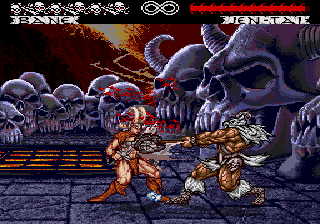 The more I play WeaponLord, the more I like what I see. It almost seems like the spiritual forefather of Soul Calibur, with its weapons-based combat and exotic locales. The characters are interesting, the visuals are great, and storyline is quite deep for a fighting game. Thankfully, Namco decided to not pursue the whole bloodshed angle, since placing the emphasis on such a novelty would have left WeaponLord as just another “me too” clone.
The more I play WeaponLord, the more I like what I see. It almost seems like the spiritual forefather of Soul Calibur, with its weapons-based combat and exotic locales. The characters are interesting, the visuals are great, and storyline is quite deep for a fighting game. Thankfully, Namco decided to not pursue the whole bloodshed angle, since placing the emphasis on such a novelty would have left WeaponLord as just another “me too” clone.
The gameplay is as deep as the plot, and the repertoire of movements available to you can sometimes be overwhelming to accomplish correctly. Playing with a three-button pad is naturally useless, but even with the six-button controller executing the moves for a combo can be more challenging than it should be. The payoff can be very exciting, however, since multiple hits can be chained straight into a special move that can be done over and over, resulting in total decimation of your opponent. This is most satisfying, and it gives WeaponLord‘s learning curve some legitimacy many other fighters are lacking.
World Heroes
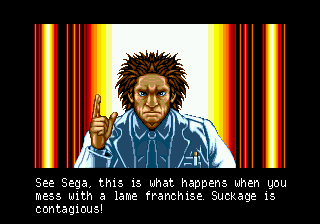 Takara really went nuts with the Neo Geo ports, and Sega obviously wanted a piece of the pie. With all the quality brands they own, I have to question why the hell Sega would decide to release this. I know this series was popular enough in arcades, but why not go for something different? I would have greatly appreciated some Cyber Lip or Magician Lord instead of World Heroes, but we live with what we have. It wouldn’t be so bad if this were actually a decent game. Apparently, Sega thought they could farm it out after they themselves got the license, and the result is probably the worst version of an already mediocre title. Who the hell were the “Sega Midwest Division” and why were they behind this conversion? Moreover, why even bother with this when a better version had already been released on the SNES a year earlier? I suspect that by this time, the chimps in charge at Sega were already feeling the effects of the T-Virus, so their judgment was worse than usual. Avoid.
Takara really went nuts with the Neo Geo ports, and Sega obviously wanted a piece of the pie. With all the quality brands they own, I have to question why the hell Sega would decide to release this. I know this series was popular enough in arcades, but why not go for something different? I would have greatly appreciated some Cyber Lip or Magician Lord instead of World Heroes, but we live with what we have. It wouldn’t be so bad if this were actually a decent game. Apparently, Sega thought they could farm it out after they themselves got the license, and the result is probably the worst version of an already mediocre title. Who the hell were the “Sega Midwest Division” and why were they behind this conversion? Moreover, why even bother with this when a better version had already been released on the SNES a year earlier? I suspect that by this time, the chimps in charge at Sega were already feeling the effects of the T-Virus, so their judgment was worse than usual. Avoid.
Yu Yu Hakusho Battle
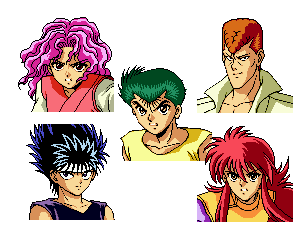 Madness. That’s about the best term to describe Yu Yu Hakusho with four players. There’s so much going on that you’re left dizzy. Treasure’s multi-player fighter is highly revered among Genesis gamers, and the prices it commands on eBay only make it that much more desirable. Based on the popular anime, players can choose from eleven different characters to battle it out over eight beautiful stages in some of the most frantic action ever put onto a cart. Everything about this game screams quality, and once you play it, you’ll see why it’s so highly regarded. No knowledge of the anime is required, so you can get right to whooping your pals. You will, of course, need a four player adapter to make the most out of Yu Yu Hakusho, but the investment is well worth it. A welcome change of pace from standard one-on-one fighters of the day, it was one of the first to show just how much fun a free-for-all brawl could be. Still is, too.
Madness. That’s about the best term to describe Yu Yu Hakusho with four players. There’s so much going on that you’re left dizzy. Treasure’s multi-player fighter is highly revered among Genesis gamers, and the prices it commands on eBay only make it that much more desirable. Based on the popular anime, players can choose from eleven different characters to battle it out over eight beautiful stages in some of the most frantic action ever put onto a cart. Everything about this game screams quality, and once you play it, you’ll see why it’s so highly regarded. No knowledge of the anime is required, so you can get right to whooping your pals. You will, of course, need a four player adapter to make the most out of Yu Yu Hakusho, but the investment is well worth it. A welcome change of pace from standard one-on-one fighters of the day, it was one of the first to show just how much fun a free-for-all brawl could be. Still is, too.
It seems like I’ve said it before – probably because I have – but we have here another genre where the Genesis is said to be lacking, though a headcount shows otherwise. With almost fifty games to its credit, the platform is pretty healthy in this area. As with all consoles, there’s good and there’s bad, but generally speaking, what’s available is enough to satisfy any 16-bit gamer’s fighting fix.

Recent Comments